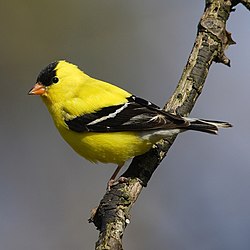 New York City became the ninth city in the nation this week to sign an Urban Conservation Treaty for Migratory Birds. The Treaty, a partnership among The U.S. Fish and Wildlife Service (Service), New York City Parks and Recreation, Audubon New York and New York City Audubon, is a commitment to restore, conserve and protect valuable bird habitat within New York City's urban environment and to develop an informed public through education and training programs.
New York City became the ninth city in the nation this week to sign an Urban Conservation Treaty for Migratory Birds. The Treaty, a partnership among The U.S. Fish and Wildlife Service (Service), New York City Parks and Recreation, Audubon New York and New York City Audubon, is a commitment to restore, conserve and protect valuable bird habitat within New York City's urban environment and to develop an informed public through education and training programs. New York City Becomes Ninth City To Join Bird Treaty
Ponds, lakes, native trees, and other plant life in city parks can provide important resting and breeding grounds for thousands of migrating birds that fly through New York and other cities every spring and fall. With nearly 53,000 acres of open space and parkland, New York City has much to offer to migrating birds on the Atlantic coast.
As part of the Treaty commitment, partners will work together to improve New York City’s bird habitat by increasing stewardship, providing restoration of key areas and ensuring proper monitoring in all New York City natural areas, including the City’s Important Bird Areas, Forever Wild sites, and other critical habitats.
Birds are an aesthetic, cultural, scientific and economic resource to the Nation. Through this agreement, partners will work with New York City to heighten public awareness of birds and the importance of open space to bird conservation through public programs and events, including education programs for school children and citizen scientists. The City will also increase and improve protected natural areas, restore and protect existing nesting areas such as North Brother Island and the Rockaway Beach Endangered Species Nesting Area, and develop a green-collar workforce through the GreenApple Corps program.
"I am honored to join with the U.S. Fish and Wildlife Service to aid in its efforts to protect migratory birds," said Parks & Recreation Commissioner Adrian Benepe. "New York City's parks are a crucial stopover for migratory birds and that is why it is critical that our parks provide a hospitable environment to these important members of our ecosystem. Today's agreement is a testament to the high quality of natural areas in New York City parks, thanks to ongoing support from scientists, activists, local elected officials, community members, and public-private partnerships."
It's good that Parks seems to finally be coming to their senses. Hopefully, this will protect Ridgewood Reservoir. Basin #3, which Parks previously wanted to develop, hosts the highest diversity of bird species of the 3 basins, per Parks' own commissioned report:
"West Basin
The West Basin had the high species richness and abundance, supporting species from the widest variety of guilds, due to the increased compositional and structural diversity of habitats at the site relative to other areas. Five species of sparrows were seen actively feeding on the ground of the open grassy meadow bordered by birch trees, for example. Indigo Buntings were seen along the edge of the meadow, and nearly 13 species of warbler were observed foraging in the canopy trees, while several warblers tended to utilize scattered low shrubs or stands of reed grass (Common Yellowthroat specifically, but also Ovenbird). Flocks of Kinglets, both Ruby-crowned and Golden-crowned foraged extensively in the birch and poplar stands, as did mixed flocks of Northern Parulas, Black-throated Green Warblers, Black-capped Chickadees, and Ruby-crowned Kinglets. The Southeast quadrant of the west basin, which was more uniformly in habitat, supported mainly warblers and the mixed feeding flocks previously described. The black locust/mugwort forest to the north supported Black- and-white, Northern Parula, Black-throated Green, and Nashville Warblers, as well as numerous woodpeckers including Downy, Red-bellied and Northern Flicker. Both Coopers Hawks (Special Concern) and Sharp-shinned Hawks (Special Concern) were observed hunting in the entire west basin. Where understory shrubs existed in the north section, various sparrows could be found, including good numbers of White-throated, Swamp and a single Lincoln’s. The eastern edge of the west basin was more diverse with fruiting shrubs and attracted many Gray Catbirds, American Robins, and two species of Catharus trush (Swainson’s and Gray-cheeked)."
 Click chart for larger version.
Click chart for larger version.




3 comments:
If Bloomberg/Benepe really had their way the only birds we'd be seeing in NYC's concrete jungle are the pigeons!
So we "protect" the birds but destroy their homes!
Duh, uh, doesn't that drive them away or kill them?
Thanks for St. Saviour's
and (soon) the Reservoir you pair of bird-brained bastards!
Too bad these sites aren't
Central Park on the golden isle!
This can be trouble.
Here, in Buffalo, we lost an opportunity for signature bridge, due to possible impacts on the migratory birds.
http://www.worldarchitecturenews.com/index.php?fuseaction=wanappln.projectview&upload_id=2212
So what? The birds were saved and you still have a connection to Canada. It's called compromise.
Post a Comment